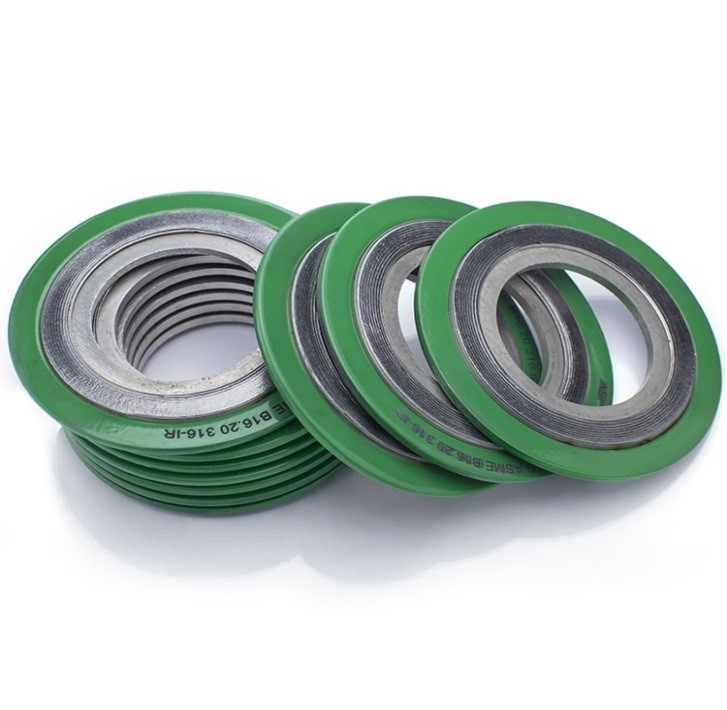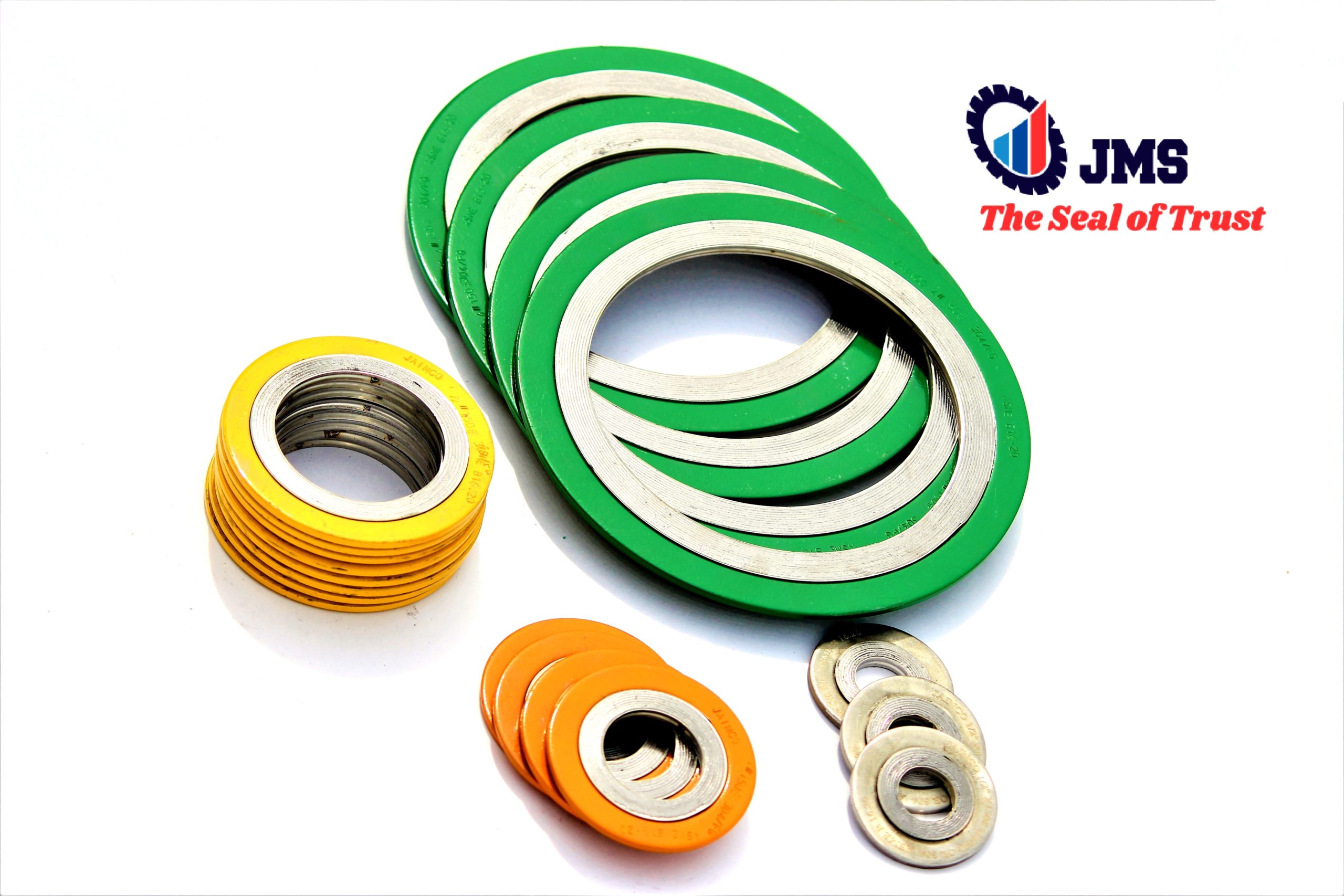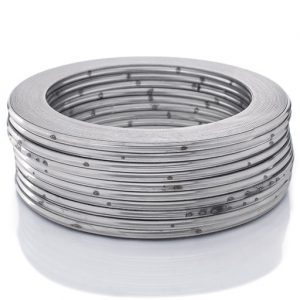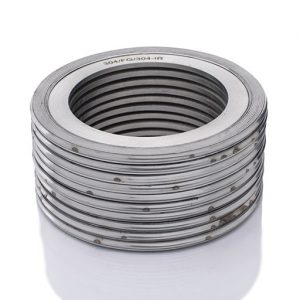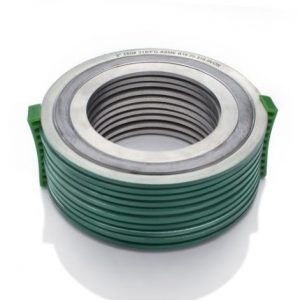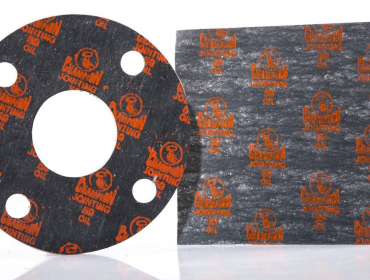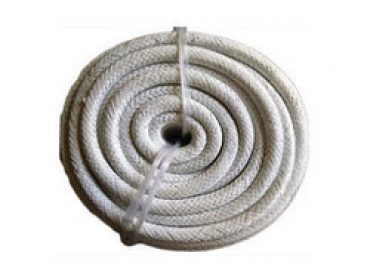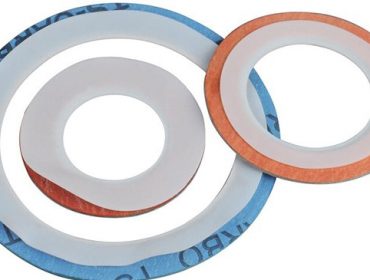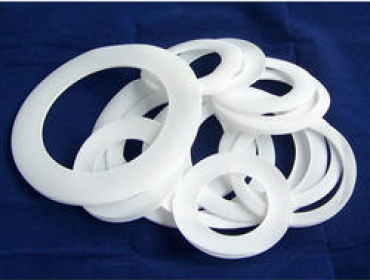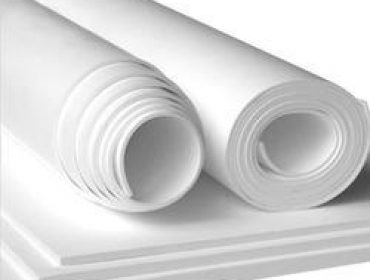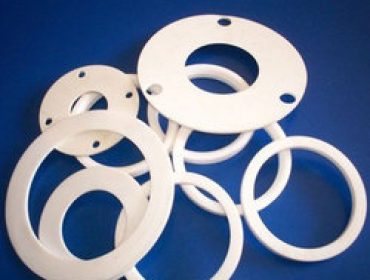Spiral Wound Gasket Manufacturer
It requires specialized equipments to manufacture spiral-wound gaskets. We are one of the leading manufacturers under brand “JAINCO”. If you have an application for gaskets that you think needs a technical suggestion, call or email to us and we’ll be happy to help you.
Spiral-wound gaskets excel in flange and pipe applications that see big fluctuations in temperature and pressure. (The type of environment which makes bolts lengthen and clamping pressure drop etc.) In addition to these , when the non-metallic element/filler is PTFE or graphite these gaskets also provide excellent resistance to chemical attack. Which is why spiral-wound gaskets are the gasket of choice in Oil refineries and related petrochemical applications of Industries.
Totally compatible with the closure of flange in which it is to be used, spiral wound gaskets (SPW Gaskets) can also be used over the complete range of temperatures from cryogenic to approx 2000°F and also in all pressure ranges from vacuum to the standard 2500 psi flange ratings, which makes it a high pressure and high temperature resilient gasket. They are more resilient to fluctuating conditions than any other type of metal gasket with higher flexibility rate and recovery characteristics in maintaining a seal under variable working conditions.
Standard spiral wound constructions consist of a winding element that is .175-in thick with a corresponding outer guide ring thickness of .125-in (nominal). This allows for an approximate 30 percent compression to the winding element when installed. The groove recess should allow a comparable compression during assembly to maximize the performance of the seal. This example represents a typical construction design and other thicknesses can apply. The deflection percentage mentioned is a typical value for any thickness.As gaskets designed for different operating conditions often vary in density and compression characteristics, it is wise to use recommended torque values and fastener lubricants per manufacturers’ specifications.
Spiral Wound Gasket Description
“JAINCO” Spiral wound gaskets consist s a spiral shaped wound which is a combination of non-metallic tape made from CAF/AF/graphite/PTFE or mica and a profiled stainless steel 316/304 etc or steel tape. The spiral gasket is then fitted with a supporting ring on the inner dia and/or a centering ring on the outer dia ie depending on the application area. We can distinguish Spiral wound gaskets as follows in their design depending on the flange surface:
- Flanges with a raised face:
- Must use spiral wound gaskets with inner as well as centering ring
- For Male Flanges and female flanges:
- Must use spiral wound gaskets with inner ring
- For Flanges with tongue/groove:
- Must use spiral wound gaskets without inner as well as centering ring
Spiral wound gaskets which are used for flanges following DIN EN 1092 standards are described and manufactured by following DIN EN 1514-2 standards with regards to the design and dimensions of gasket; deviating from this, the dimensions for flanges with tongue/groove applications are specified in DIN EN 1514-1, form TG. For flange connections following standards ASME B16.5, the ASME B16.20 standards as well as DIN EN 12560-2 standards are the normative basis for design and dimensional specifications for spiral wound gaskets.
The Spiral wound gaskets are specifically used in critical operating conditions and also in high pressure range applications due to their specific characteristics profile. The spiral wound gaskets are well-suited for Fluctuating/alternating loads accompanied with component expansion differences in addition to the high temperature limits ie [450 °C for graphite, higher temperatures also possible depending on the design of gasket] and the pressure operating limit ie [320 bar]. Spiral wound gaskets easily balance these differences while also exhibiting very low leakage rates.
Spiral wound gaskets does comply with TA Luft 2002 [VDI 2440/2200] standards and the proof for VDI 2290 can also be supplied if required. The targeted selection of filler/spiral material components and variation in the set-up of gasket allows the gasket system to adjust to the requirements of different media and varying operating conditions. The “Minimum Stress” [MS] version of gasket, which is optimized with regards to the design as well as construction should be used for flanges as per ASME B16.5 standards [e.g. Class 150 lbs.] or for the flange connections that are not suitable for standard spiral wound gaskets which follows ASME B16.20 standards, because of bolt forces.
- Managing the alternating load (Eg: The loads during start-up and shut-down procedures).
- Temperature resistance properties depending on the non-metallic filler material and Spiral metal materials.
- Constant temperature range for Filler of PTFE: -200 °C to approx.250°C.
- Constant temperature range for Filler of graphite: -200°C to approx.450 °C, higher temperatures are also possible depending on the design of gasket.
- Media resistance depending on the non-metallic Filler material and Spiral metal material.
- Very high-pressure withstanding limits of up to 320 bar.
- Complies with TA Luft 2002 [VDI 2440/2200] standard leakage requirements.
- Complies with VDI 2290 [with calculatory leakage certificate following DIN EN 1591-1].
- Fire Safe Test [Graphite Filler].
- Blow-out resistance [graphite filler].
- BAM-test reports for liquid and gaseous oxygen applications [graphite filler].
- BAM-test report for ethylene and propylene oxide applications [graphite filler].
- FDA-conformation [PTFE Filler].
- No ageing and embrittlement of gaskets even at high temperatures.
- Labeling for design with centering ring.
- Established sealing system for the chemical and petro-chemical sector, in conventional power and nuclear power stations, for steam generation and in device construction, especially wherever high temperatures and pressures have to be managed safely.
- Can be used in pipelines, flanges, device/container flanges, also in pumps and valves.
- These gaskets can be used for very high operating pressures and/or temperature conditions
- Flange roughness of Rz<=80 „µm“ is recommended.
- Can be supplied with filler of graphite or PTFE as non-metallic material, for higher temperature ranges >= 550°C with insert of mica or spiral made from 1.4828.
- Dimensions of gaskets and set-up following DIN EN 1514-2 standards, DIN EN 12560-2 standards and ASME B16.20, flange according to ASME B16.47 series A and B;
- Spiral wound with filler Material for use in tongue/groove flanges.
- Spiral wound with filler Material with inner- and centering ring for use in raised face flanges.
- Spiral wound with filler Material accompanied with centering ring.
- Spiral wound with filler Material and inner ring.
- Dimensions and set-up following DIN EN 1514-2,DIN EN 12560-2 and ASME B16.20, flange according to ASME B16.47 series A and B;
- Wound spiral with filler for tongue/groove flanges.
- Wound spiral with filler with inner- and centering ring for raised face flanges.
- Wound spiral with filler and centering ring.
- Wound spiral with filler and inner ring.
- Manufacturer
- Nominal width
- Nominal pressure stage
- Material of the inner ring, spiral, filler material and centering ring
- Colour coding following DIN EN 1514-2 or ASME B16.20
History of Spiral Wound Gasket
Spiral-wound gaskets uses a mix of metallic spiral material and “filler material” generally the gasket has a chosen carbon rich or stainless steel metal, wound outwards in a circle shape ( other shapes are also possible but this is the primary) with the filler non metallic material ie generally a flexible graphite/PTFE , starting at the opposite side of circle and parallely winding in the same direction which leads to a circle growing with alternating layers of filler material and metal. These spiral wound gaskets have proven to be most reliable in almost all applications and although they are more expensive than solid material but do not require such high bolt forces to be proven effective. This is possibly because the graphite is the one which makes the primary seal with the flange and the metal only acting to keep the gasket structurally sound.
A constant seating stress gasket, which was introduced in 2005, reflects a revolutionary advancement in designing of gaskets. These gaskets consists of two components ie a solid carrier ring of a any suitable material, such as stainless steel, along with two sealing elements of any compressible material which is installed within the two opposing channels,with one channel on either side of the carrier ring. These filler/ sealing elements are made from materials such as (expanded graphite , CAF/AF Strips, expanded polytetraflouroethylene (PTFE), vermiculite etc) which is suitable to the application. These Constant seating stress gaskets get their name from the fact that the carrier ring or the profile takes flange rotation (deflection under bolt preload) into consideration. while all other conventional gaskets, when the flange fasteners/bolts are tightened, the flanges deflects radially under the load, which results in the greatest compression of gasket, and highest stress at the outer edge of gasket . Now since the carrier is ring used in the constant seating stress gaskets, it takes this deflection into account and while creating the carrier ring for a given size of flange, class of pressure and material, the ring profile can be adjusted which enables the gasket seating stress to be distributed radially uniformly across the entire sealing area. Further, since these sealing/filler materials are fully confined by the flange faces in opposite channels on the carrier ring, any kind of in-service compressive force acting on the gasket will be transmitted through the gaskets carrier ring and will avoid any further compression of these sealing elements, thus maintaining a ‘constant’ gasket seating stress while in-service. Hence, this gasket is immune to the common gasket failures which includes creep relaxation, high system vibration, or system thermal cycles. The fundamental concept underlying the improved seal ability for constant seating stress gaskets are that (i) if the flange sealing surfaces are capable of attaining a seal, (ii) the sealing elements are compatible with the process fluid and application, and (iii) the sufficient gasket seating stress is achieved on installation necessary to affect a seal, then the possibility of the gasket leaking in-service is greatly reduced or eliminated altogether.
We offer Full array of services To Deliver One Stop reliability to counter all your needs. From Management to Production we are committed to excellence at all levels of services, operations and wide range of Industrial applications.
Our Company supplies various products to many industries all over country. We have extensive experience of working with Professionals and engineers to solve your problems, and to supply parts that meet accurate specifications. We manufacture all types of gaskets and seals, for a wide variety of conditions and environments.
Jain Mill Stores is unconditionally committed towards its customer’s satisfaction and success by consistently being transparent to establish mutual trust & understanding, ensuring timely delivery of all products as per customer’s need.
Q & A
Spiral wound gaskets can be used for sealing flange joints, manhole and handhold covers, tube covers, boilers, heat exchangers, pressure vessels, pumps, compressors and valves; in industries such as petrochemical, pharmaceutical, shipbuilding, and food processing, in power industries and nuclear power stations.
Most gaskets are cut from sheet material and that means they seal on their flat surfaces. When flanges are out of parallel the gap between them varies, forcing the use of thicker material. Where the gap is smaller the material must compress more. Pretty quickly the material reaches the limits of what it can do.
Solid metal gaskets are more expensive. This type of gasket consists of a grooved metal plate with a process-compatible sealer filling the groove. Under load, the material in the groove compresses and seals the process. With proper maintenance, which includes sealer reapplication, these gaskets can be reused.

